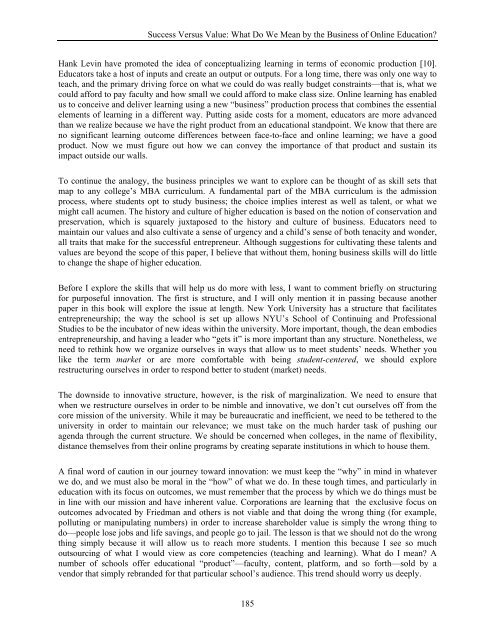Elements of Quality Online Education cation
Elements of Quality Online Education cation
Elements of Quality Online Education cation
You also want an ePaper? Increase the reach of your titles
YUMPU automatically turns print PDFs into web optimized ePapers that Google loves.
Success Versus Value: What Do We Mean by the Business <strong>of</strong> <strong>Online</strong> <strong>Edu<strong>cation</strong></strong>?Hank Levin have promoted the idea <strong>of</strong> conceptualizing learning in terms <strong>of</strong> economic production [10].Educators take a host <strong>of</strong> inputs and create an output or outputs. For a long time, there was only one way toteach, and the primary driving force on what we could do was really budget constraints—that is, what wecould afford to pay faculty and how small we could afford to make class size. <strong>Online</strong> learning has enabledus to conceive and deliver learning using a new “business” production process that combines the essentialelements <strong>of</strong> learning in a different way. Putting aside costs for a moment, educators are more advancedthan we realize because we have the right product from an edu<strong>cation</strong>al standpoint. We know that there areno significant learning outcome differences between face-to-face and online learning; we have a goodproduct. Now we must figure out how we can convey the importance <strong>of</strong> that product and sustain itsimpact outside our walls.To continue the analogy, the business principles we want to explore can be thought <strong>of</strong> as skill sets thatmap to any college’s MBA curriculum. A fundamental part <strong>of</strong> the MBA curriculum is the admissionprocess, where students opt to study business; the choice implies interest as well as talent, or what wemight call acumen. The history and culture <strong>of</strong> higher edu<strong>cation</strong> is based on the notion <strong>of</strong> conservation andpreservation, which is squarely juxtaposed to the history and culture <strong>of</strong> business. Educators need tomaintain our values and also cultivate a sense <strong>of</strong> urgency and a child’s sense <strong>of</strong> both tenacity and wonder,all traits that make for the successful entrepreneur. Although suggestions for cultivating these talents andvalues are beyond the scope <strong>of</strong> this paper, I believe that without them, honing business skills will do littleto change the shape <strong>of</strong> higher edu<strong>cation</strong>.Before I explore the skills that will help us do more with less, I want to comment briefly on structuringfor purposeful innovation. The first is structure, and I will only mention it in passing because anotherpaper in this book will explore the issue at length. New York University has a structure that facilitatesentrepreneurship; the way the school is set up allows NYU’s School <strong>of</strong> Continuing and Pr<strong>of</strong>essionalStudies to be the incubator <strong>of</strong> new ideas within the university. More important, though, the dean embodiesentrepreneurship, and having a leader who “gets it” is more important than any structure. Nonetheless, weneed to rethink how we organize ourselves in ways that allow us to meet students’ needs. Whether youlike the term market or are more comfortable with being student-centered, we should explorerestructuring ourselves in order to respond better to student (market) needs.The downside to innovative structure, however, is the risk <strong>of</strong> marginalization. We need to ensure thatwhen we restructure ourselves in order to be nimble and innovative, we don’t cut ourselves <strong>of</strong>f from thecore mission <strong>of</strong> the university. While it may be bureaucratic and inefficient, we need to be tethered to theuniversity in order to maintain our relevance; we must take on the much harder task <strong>of</strong> pushing ouragenda through the current structure. We should be concerned when colleges, in the name <strong>of</strong> flexibility,distance themselves from their online programs by creating separate institutions in which to house them.A final word <strong>of</strong> caution in our journey toward innovation: we must keep the “why” in mind in whateverwe do, and we must also be moral in the “how” <strong>of</strong> what we do. In these tough times, and particularly inedu<strong>cation</strong> with its focus on outcomes, we must remember that the process by which we do things must bein line with our mission and have inherent value. Corporations are learning that the exclusive focus onoutcomes advocated by Friedman and others is not viable and that doing the wrong thing (for example,polluting or manipulating numbers) in order to increase shareholder value is simply the wrong thing todo—people lose jobs and life savings, and people go to jail. The lesson is that we should not do the wrongthing simply because it will allow us to reach more students. I mention this because I see so muchoutsourcing <strong>of</strong> what I would view as core competencies (teaching and learning). What do I mean? Anumber <strong>of</strong> schools <strong>of</strong>fer edu<strong>cation</strong>al “product”—faculty, content, platform, and so forth—sold by avendor that simply rebranded for that particular school’s audience. This trend should worry us deeply.185
















